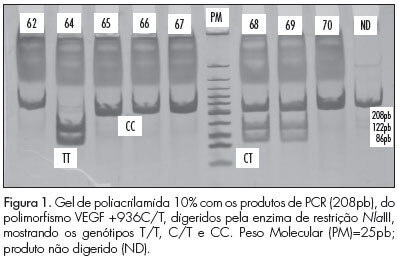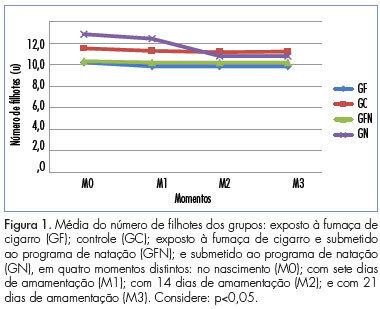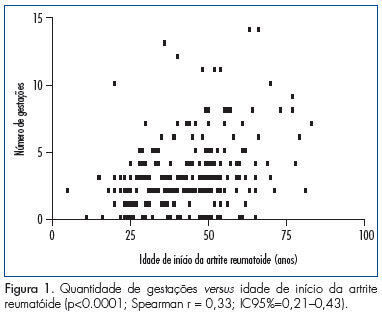Summary
Revista Brasileira de Ginecologia e Obstetrícia. 2011;33(7):158-163
DOI 10.1590/S0100-72032011000700007
PURPOSE: To identify genetic polymorphisms of endothelial growth factor (VEGF), positions +936C/T and -2578C/A, in women with pre-eclampsia. METHODS: This was a cross-sectional study conducted on 80 women divided into two groups: pre-eclampsia and control. The sample was characterized using a pre-structured interview and data transcribed from the medical records. DNA extraction, amplification of sequences by the Polymerase Chain Reaction (PCR) with specific primers and polymorphism analysis of Restriction Fragment Length Polymorphism (RFLP) were performed to identify polymorphisms. The statistical analysis was performedin a descriptive manner and using the ![]() test. The multiple logistic regression model was used to determine the effect of polymorphisms on pre-eclampsia. RESULTS:Ahigher frequency of the T allele of theVEGF +936C/T polymorphism was observedin patients with pre-eclampsia, but with no significant difference. The presence of allele A of the VEGF -2578C/A was significantly higher in the control group. CONCLUSIONS:No significant association was observed between VEGF +936C/Tpolymorphism andpre-eclampsia. For the VEGF -2578C/A polymorphism a significant differencewas observed between thecontrol and pre-eclampsia group, with allele A being the most frequent in the control, suggesting the possibility that carriers of allele A have lower susceptibility to the development of pre-eclampsia.
test. The multiple logistic regression model was used to determine the effect of polymorphisms on pre-eclampsia. RESULTS:Ahigher frequency of the T allele of theVEGF +936C/T polymorphism was observedin patients with pre-eclampsia, but with no significant difference. The presence of allele A of the VEGF -2578C/A was significantly higher in the control group. CONCLUSIONS:No significant association was observed between VEGF +936C/Tpolymorphism andpre-eclampsia. For the VEGF -2578C/A polymorphism a significant differencewas observed between thecontrol and pre-eclampsia group, with allele A being the most frequent in the control, suggesting the possibility that carriers of allele A have lower susceptibility to the development of pre-eclampsia.

Summary
Revista Brasileira de Ginecologia e Obstetrícia. 2011;33(7):150-157
DOI 10.1590/S0100-72032011000700006
PURPOSE: the purpose of this study was to evaluate mortality, weight and body length, and the gastrocnemius muscle of the offspring of pregnant rats submitted to a swimming program associated with second-hand smoke. METHODS: twenty-four rats were divided into four groups: GF (exposed to cigarette smoke), GC (control), GFN (submitted to the swimming program and exposed to cigarette smoke), and GN (submitted to the swimming program). The mortality, weight and length of the offspring were measured at four time points. The gastrocnemius muscle of the pups was obtained for evaluation of muscle development. RESULTS: the average number of offspring was lower for GF (10.2) and GFN (10.3) and higher for GN (12.8). At birth, only GFN showed significantly lower weight (p=0.016) and length (p=0.02), whereas during lactation the groups exposed to cigarette smoke showed significantly lower weight. GFN had delayed muscle development compared to GC (p=0.03). CONCLUSIONS: Passive smoking during pregnancy and lactation negatively influenced number, weight and body length of offspring from birth to weaning and muscle development, and the swimming program positively influenced these variables at birth, although it did not provide the same benefits during lactation; and their association negatively affected these measures.

Summary
Revista Brasileira de Ginecologia e Obstetrícia. 2011;33(7):132-136
DOI 10.1590/S0100-72032011000700003
PURPOSE: To study if rheumatoid arthritis (RA) is influenced by age at menarche, number of pregnancies and reproductive life span. METHODS: This was a cross-sectional and retrospective study of medical records of 247 RA patients. We collected data on menarche, menopause, number of pregnancies, autoantibodies, serositis, rheumatoid nodules, and functional index of Steinbrocker. Association studies were done using the Student t and Mann-Whitney tests and correlation was determined by the Pearsonand Spearman tests. The level of significance adopted was 5%. RESULTS: The mean age at diagnosis of RA was 43.2±14.1 years, the median age at menarche was 13 years and the median number of pregnancies was 3. Rheumatoid factor was present in 63.9% of the patients, 20% had antinuclear factor, 8.8% rheumatoid nodules, 2.8% had pleural effusion, and 2.4% had pericarditis. The Steinbrocker functional index showed that 45.6% had a score of 1, 40.8% a score of 2, 3 score of 9.1, and 4.3% a score of 4. We found an inverse correlation between the number of pregnancies and age at onset of RA (p CONCLUSION: A precocious menarche and brief reproductive life indicate a poor prognosis regarding pleurisy. A larger number of pregnancies and late menopause show a protective effect, delaying the onset of the disease.

Summary
Revista Brasileira de Ginecologia e Obstetrícia. 2011;33(4):196-204
DOI 10.1590/S0100-72032011000400008
The Crohn's disease, a form of inflammatory bowel disease, is frequent in women of childbearing age. Its management requires greater attention during pregnancy. We report a case of refractory Crohn's disease in a pregnant patient that evolued to ileocolectomy at puerperium. The literature regarding pregnant patients with Crohn's disease was reviewed, including counseling of patients and investigation of active disease, and the existing data was summarized on the safety of medications used to treat Crohn's disease in pregnancy and breastfeeding.

Summary
Revista Brasileira de Ginecologia e Obstetrícia. 2011;33(2):93-98
DOI 10.1590/S0100-72032011000200007
PURPOSE: to estimate the prevalence and risk factors associated with seropositivity for Toxoplasma gondii in pregnant women. METHODS: a cross-sectional retrospective study based on the records of women screened for toxoplasmosis by the Pregnancy Protection Program in 2008, living in Goiânia (GO). These records were connected to records from the database of the National Information System on Live Births from the State of Goiás. The process occurred in three phases, with 10,316 records being paired for analysis, among the 12,846 initial records. The following variables were evaluated in this process: woman's name, age, date of birth, estimated date of delivery, date of infant birth and household information. Anti-Toxoplasma gondii antibodies were detected with the Q-Preven Toxo IgG and IgMin tests in dried blood samples collected on filter paper. The χ2 test and χ2 test for trend were used for data analysis, and the odds ratio (OR) was used to estimate the chance of association between exposure and outcome. RESULTS: the prevalence of infection was 67.7%, with 0.7% of the samples presenting anti-Toxoplasma gondii IgM and IgG reagents. Out of these, only three did not undergo confirmatory testing in venous blood. The median interval between the screening and the new collection of venous blood was of 12.5 days, and from screening to confirmatory test and avidity it was of 20 days. The variables associated with exposure were: age 20-30 years, OR=1.6 and >31 years, OR=1.8; brown skin color, OR=1.4, and black skin color, OR=1.6; and education of 8-11 years, OR=0.7, and >12 years of education, OR=0.6. CONCLUSION: a high prevalence of infection was estimated among the studied pregnant women. The associated factors that were found found should be considered during prenatal care, along with educational activities for the prevention of infection and assessment of serological status of seronegative pregnant women.
Summary
Revista Brasileira de Ginecologia e Obstetrícia. 2011;33(2):87-92
DOI 10.1590/S0100-72032011000200006
PURPOSE: to determine the dietary consumption of pregnant women, by assessing the intake of macronutrients and micronutrients, and to verify the maternal weight gain during pregnancy. METHODS: a retrospective study conducted from June 2002 to June 2008 with pregnant women who received nutritional counseling during prenatal care at a university hospital, grouped according to anthropometric nutritional status classified by pregestational body mass index (BMI). The dietary intake was analyzed according to the information obtained in food frequency interviews, performed at the first evaluation of pregnant women in the service of nutrition to obtain data about eating habits, and the intake of macronutrients and micronutrients was calculated. The pregnant women received nutritional counseling, and the maternal weight gain was investigated. RESULTS: a total of 187 pregnant women who received nutritional counseling were analyzed. Twenty-three (12.2%) were underweight, 84 (45.0%) normal weight, 37 (19.8%) overweight, and 43 (23.0%) obese. The underweight pregnant women had lower consumption of lipids when compared to the normal weight group (101.4 versus 137.3 g; p=0.043). The average iron intake was higher in normal weight pregnant women (14.6 mg/d) compared to the overweight (12.2 mg/d) or obese (10.9 mg/d; p<0.001) groups. The average intake of folate was higher in normal weight pregnant women compared to obese ones (336.5 µg/d versus 234.5 µg/d; p=0.002). Excessive maternal weight gain was significantly (p=0.009) more frequent in overweight (56.7%) and obese (39.5%) pregnant women compared to underweight (17.4%) and normal weight (31.0%) women. CONCLUSIONS: The maternal weight gain above recommended levels was associated with overweight and obesity. The dietary intake of pregnant women differs according to maternal anthropometric nutritional status, with a lower daily intake of iron in overweight and obese women and a lower intake of folate in obese ones, a fact that reinforces the importance of prenatal vitamin supplementation.
Summary
Revista Brasileira de Ginecologia e Obstetrícia. 2011;33(2):81-86
DOI 10.1590/S0100-72032011000200005
PURPOSE: to determine the prevalence of adverse gestational and neonatal outcomes in women with a positive screening and negative diagnosis for gestational diabetes mellitus (GDM). METHODS: a retrospective descriptive cross-sectional study was conducted from 2000 to 2009 on 409 women with positive screening for GDM. The maternal variables studied were: age, body mass index, history of cesarean section, macrosomia or diabetes mellitus in a previous pregnancy and a personal or family history of diabetes mellitus and chronic arterial hypertension. The neonatal variables studied were: polyhydramnios, gestational age at birth, prematurity, cesarean delivery, large for gestational age (LGA) newborn, macrosomia, Apgar score, neonatal respiratory distress syndrome, hypoglycemia and hyperbilirubinemia. Uni- and multivariate descriptive analyses were first performed regarding risk factors and neonatal outcome and the prevalences and respective 95% confidence intervals were determined. RESULTS: the route of delivery was cesarian section in 255 cases (62.3%), preterm birth occurred in 14.2% of cases and 19.3% of the newborns were LGA. The risk factors correlated with LGA newborns were overweight or obesity, maternal age and a history of macrosomia in a previous pregnancy. CONCLUSIONS: a high rate of LGA newborns was observed in the population with positive risk factors or altered fasting glycemia on the occasion of the first prenatal visit, even when the glycemia curve was normal, with cesarean rates above those habitually observed in populations considered to be of low risk. Pregnant women with these characteristics represent a differential group.
